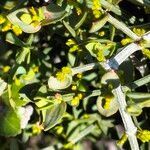Leafy, monoecious, hemiparasitic shrub, 0.2-0.5 m. high, often forming densely branched, rounded clusters, pale green; internodes rounded, 6-ribbed. Leaves ± sessile, variable, ovate-suborbicular to elliptic-oblong, often 3-nerved from base. Dichasia primarily with central flower staminate, lateral ones pistillate; bearing a short stalk. Flowering time Apr.-Aug., but possibly all year. Fruit a stalked, ellipsoid berry, orange, smooth; style persistent.
An evergreen shrub that grows attached to other plants. It grows 50 cm high. It is a leafy plant often forming small round clusters. The leaves vary in shape from almost round to narrowly oval. They are 8-12 mm long by 4-8 mm wide. The fruit are bright red berries with a sticky pulp. They are 4-5 mm long.
Leafy, monoecious shrub, up to 0.5 m high; parasitic on many diverse hosts including, for example, species of Euclea and Boscia. Stems with internodes usually > 12 mm long. Leaves usually > 8 x 4 mm. Flowers: yellow; Jul.-Dec. Fruit orange, 4-5 mm long, with pedicel 3-4 mm long.
Leafy, monoecious shrub, up to 500 mm tall. Internodes usually longer than 12 mm. Parasitic on many diverse hosts including species of Euclea, Boscia. Leaves usually more than 8 x 4 mm. Berries orange, 4-5 mm long, with pedicel 3-4 mm long. Flowers yellow.
Leafy, monoecious, stem parasite, < 0.5 m tall, internodes of distal branches 12-20 x 1-1.5 mm, 6-ribbed. Leaves ovate to ± circular to elliptic-oblong. Inflorescence of both male and female flowers. Berry 4-5 mm long, smooth, orange, shortly pedicillate.
Leaves ± sessile, highly variable, 8–12 × 4–8 mm, ovate-subcircular to elliptic-oblong, apex obtuse to acute, usually minutely apiculate, base rounded to cuneate, often 3-nerved from base, usually glaucous.
Leafy, monoecious, small shrubs often forming rounded, densely branched clusters <0.5 m high, mostly light, pale green, glaucous; internodes of distal branches 12–20 × 1–1.5 mm, rounded, 6-ribbed.
Like V. pauciflorum but leaves smaller, up to 12 mm long, and usually obtuse at base.
Dichasia primarily with central flower staminate and lateral flowers pistillate.
Berries pedicellate (1–2 mm), orange, 4–5 mm high, ellipsoid, smooth.
Ring scar left by perianth not strongly evident, 0.5 mm in diameter.
Style hardly evident; stigma not expanded.
Bracteal cups pedunculate (1.0 mm).

